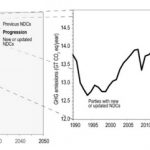The newly elected Labour government in the UK is promising to create a state-owned entity, GB Energy, to drive forward its energy transition. Robert Johnston at CGEP explains what it is, and how it could be a model for other nations. Up until now, the policy toolkit of high-income OECD countries has primarily been the use of subsidies, tax credits, government procurement, R&D grants, trade policy and the like. GB Energy will directly invest … [Read more...]
Green Steelmakers’ global future: importing the Iron from where Renewables are cheap, the Ore abundant
Governments in Europe have allocated around €5bn to 10 commercial-scale hydrogen-ready DRI (direct reduced iron) facilities for steelmaking, but even with these generous subsidies steelmakers are struggling to reach final investment decisions, citing high costs for domestic hydrogen as a barrier. And when you consider that over €400bn is needed to transition the entire European sector to hydrogen-based steelmaking, a totally new way of thinking … [Read more...]
Agrivoltaics: GWs of solar power from farmland using strategically placed panels (and raising crop yields)
In Canada and the U.S. “agrivoltaics” are taking off. It’s when solar panels are laid out strategically on farmland. After concerns that it will obstruct farm machinery and lower crop yields, studies have shown that panels – on a large scale – can be placed so that they do not. In fact, certain crop yields can be raised when the panels are used to shield them from direct sunlight, explains Joshua Pearce at Western University, Canada. He looks at … [Read more...]
Russia’s oil export revenue rebounded in March–April. Why aren’t the EU, U.S. and partners enforcing the price cap?
The Price Cap Coalition (PCC) - composed of Australia, Canada, the EU, Japan, the UK, and the U.S. – are failing to either enforce or lower the cap on Russian oil exports as promised, says a report summarised here from the Centre for Research in Energy and Clean Air (CREA). Had it done so, Russian revenues could have been slashed by €22bn (37%) since December by lowering the price cap for crude oil to $30/barrel and revising the caps for oil … [Read more...]
Canada to tap Dormant Volcanoes for Geothermal energy
Live volcanoes might be an obvious source of geothermal energy if it wasn’t for the fact they were dangerous. But dormant volcanoes aren’t, yet they still host vast reservoirs of natural heat near the Earth’s surface. So Canada is looking to generate power from Mount Meager and Mount Cayley, two dormant volcanoes north of Vancouver, explains Lizzy Rosenberg writing for the World Economic Forum. Although Canada isn't known for its volcanoes, its … [Read more...]
Energy security concerns are building momentum for Nuclear
The IEA’s latest report on nuclear power recommends a doubling of capacity by 2050. It emphasises that, though many advanced economies are planning a decline, 32 nations have nuclear today and reactors are now under construction in 19 countries. It’s evidence of a momentum behind nuclear power that should be further stimulated by recent spikes in oil, gas and electricity prices, says the IEA. Russia and China remain nuclear advocates, which … [Read more...]
Net-zero targets delayed by fossil fuel investors suing governments
As nations try to phase out fossil fuels, companies are suing them for compensation. Rachel Thrasher at Boston University, Blake Simmons at Colorado State University and Kyla Tienhaara at Queen's University (Ontario) summarise their latest study of the scale of the payouts. The cases are based on treaties – the Energy Charter Treaty being the most significant - that allow investors to sue governments when policy changes overturn their … [Read more...]
Our Hydrogen future: 27 authors imagine the world in 2030-2050
Here’s something very different for our readers today, and an opportunity for you to register for our Webinar and Q&A on Wednesday Feb 16th at 09:00 CET (register here). It’s to mark the book launch of “Touching Hydrogen Future”, where 27 energy experts from around the world have written a chapter each. They are fictional accounts of what our world could like in the near future. The countries covered are the Netherlands (2029), Denmark … [Read more...]
The Green Hydrogen disruption: what nations, firms and investors are doing to reshape global energy
Everyone knows the new hydrogen economy has huge up front capital costs to make the green H2 (called GH2), the logistical challenges of delivering it where it’s needed, and creating the customer base to consume it. But Tim Buckley at IEEFA believes the policy support is already shaping up to make GH2 a successful disruptor of the global energy system. He runs through the nations, companies and investors at the beginning of the learning curve that … [Read more...]
Will this be the decade of Carbon Capture or another false start?
Ten years ago there was a major drive to get carbon capture off the ground. But only 30% of the earmarked $8.5bn worldwide was ever spent. Spending timescales were too short, deadlines were missed, projects were too focussed and too complex, and long-term liability was poorly understood and managed. This time it can be different, says Samantha McCulloch at the IEA who compares that faltering history with the plans now being put in place. New … [Read more...]
Renewed interest in Carbon Capture strategies for net-zero: targets, obstacles, costs, priorities
Martina Lyons at IRENA picks out the highlights of their new report “Reaching Zero with Renewables: Capturing Carbon”. Carbon capture is going to be expensive, so should be focussed on hard-to-abate industrial sectors, as well as bioenergy plants. Lyons breaks down the target carbon capture volumes, costs and the investments required, as well as looking at the consequences of different strategies and carbon prices. Scaling up this technology, … [Read more...]
Coal phase-out by 21 nations only accounts for 3.2% of global power. What about the others?
The 21 nations committed to coal phase-out only account for 3.2% of global electricity generation. Three - Belgium, Austria and Sweden – have already done so. The rest hope to by different dates, ranging to 2040. Asia is where the main problem is, and their transition challenges are well known: growing economies, and energy security. Carlos Fernández Alvarez at the IEA spells out their recommendations, and references case studies in Canada, the … [Read more...]
Biden’s major report on critical minerals supply: domestic mining + processing, innovation, EVs, global allies + more
In June, The White House issued its 250-page report on the global critical minerals supply chain, and how the U.S. can ensure continued supply as well as build up its own mining and manufacturing base. It is the fullest picture so far of how the U.S. is evaluating mineral access and supply chain resilience, says Reed Blakemore at the Atlantic Council Global Energy Center. Here he reviews the report, in particular the section on energy which … [Read more...]
Updated NDCs: World committing to 0.5% emissions cuts by 2030. It should be 45%
The latest national climate pledges, submitted over the new year, show that the world is nowhere near meeting our emissions reductions goals. Analysis of the 48 updated “nationally determined contributions” (NDCs) submitted so far (everyone must submit by the end of this year), covering nations responsible for 29% of global emissions, shows we will have 0.5% lower emissions in 2030 compared to 2010. That’s way off the target 45% reduction needed. … [Read more...]
ANEEL: Thorium-based reactor fuel could revive Nuclear’s fortunes
A public-private consortium backed by the U.S. DoE is developing a new nuclear fuel – a mix of thorium and uranium – that looks like a major advance on the fuels currently in use, says Jim Conca. Called “Advanced Nuclear Energy for Enriched Life” (ANEEL), it has a very high fuel burn-up rate (55,000 MWd/T) compared to the usual uranium (7,000 MWd/T). That high burn-up reduces the waste by over 80%. Less spent fuel means less refuelling, less … [Read more...]
















